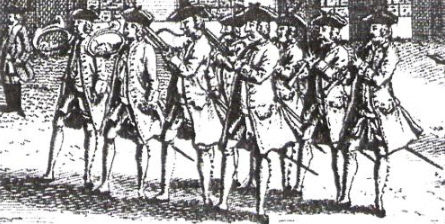|
At eleven o'clock at night I was treated to a serenade performed by two clarinets, two horns and two bassoons--and that of my own composition . . . These musicians asked that the street door might be opened and, placing themselves in the center of the courtyard, surprised me, just as I was about to undress, in the most pleasant fashion imaginable with the first chord in E-flat.
--from a letter written by W. A. Mozart to his father dated November 3, 17811
Study of the instrumentation and performance practice of 18th century instrumental music reveals the beginning of the modern symphonic orchestra as well as symphonic form. The string section had already evolved to its modern configuration during the middle to late Baroque. Except for the string bass, the violin family permanently replaced the viol family as the instrument of choice. Violin-making reached its zenith with the work of Stradivarius, and the concave bow replaced the convex allowing performers greater facility on the instrument.
Even as string instruments entered a period of relative stability, the wind instruments were about to experience a period of development and experimentation. One only has to peruse the 100+ symphonies of Haydn to see how composers experimented to find the most advantageous and pragmatic combination of instrumental color. The oboe and the bassoon were already accepted as primary soprano and bass instruments of the wind family, while a new upstart named the clarinet became all the rage, first in France and England, then in Vienna. The English horn occasionally had its moments of popularity, as did the flute, contrabassoon, and bassetthorn [an early alto clarinet equipped with an extended lower range]. Except for the French horn, brass and percussion instruments were used sparingly in symphonic form, normally being relegated to the military or the opera.
As composers experimented to determine the best combination of instruments, common practice eventually dictated using winds in pairs. Since the string section was emerging as the dominant section of the orchestra, composers used winds to provide harmonic support and color contrast to the string timbre. This led to the demise of the keyboard as harmonic support in the orchestra. Thus the term Harmoniemusik, presumably depicting this practice, became the accepted name for an ensemble of wind instruments. While ensembles of this nature were of varying sizes, the most common consisted of eight players.
In a not unrelated development, two common types of military bands also developed during this time. One type consisted of paring down a small band to an octet to perform Harmoniemusik, while the other included the basic octet plus Turkish instruments: heavy brass, percussion, and high clarinets and piccolos. However, while the word Harmonie became a pervasive term describing wind music in general, in the Classical period it is too simplistic to interpret Harmoniemusik to mean both wind band and military band. Harmoniemusik was a cultural phenomenon separate from the military band. In its most specific sense, it refers to a particular body of music written from c.1760-1837 whose primary function was to provide social entertainment.
Harmoniemusik Instrumentation
Early Harmoniemusik was scored for six instruments, even as few as four on some occasions, as indicated by the clarinet and horn bands of England and France. The clarinet was the preferred treble instrument in the west, while the Germans and Austrians generally preferred oboes. By the early 1780's the most common instrumentation, known as the Vienna tradition, consisted of 2 oboes, 2 clarinets, 2 horns, and 2 bassoons, or more concisely, 2222.2 According to tradition, in 1763 Frederick the Great was first to standardize his military bands into the octet, from which Harmonie developed. However, there seems to be no reference to prove such a claim. In fact, Roger Hellyer, a leading authority on Harmoniemusik, found no mention of clarinets in Berlin before the 1791 wedding of the Duke of York to Princess Friederike, for which Rosetti was commissioned to write two partitas for 2222.3 While eight players became the norm, there were notable exceptions. Instrumentation in the 19th century required up to twelve players, perhaps due to the increased harmonic demands of music of the Romantic period. On the occasion of the coronation of Kaiser Joseph II at Pressburg, the Harmonien of Prince Grassalkowitz and Prince Esterhazy combined to perform a piece for 21 wind instruments written by Georg Druschetsky.4
Contrabass--The Ninth Player
Frequently a contrabass line was added which brought the octet to nine players. The part was not designed as a solo line, but rather enhanced the sonority of the ensemble. Notation of contrabass lines was somewhat inconsistent, making performance practice subject to considerable confusion. For example, the second bassoon part and the contrabass line are found in the following possibilities:
1. Both written on the same part
a. Sometimes on one staff with single set of notes
b. Sometimes on one staff with two sets of notes
2. Written with two staves and two sets of notes
3. Written with two staves, the lower staff blank
The performer has to decide when to play and when not to play and what register is correct. For instance, does the contra always play an octave below the second bassoon, or if the contra line is written down an octave, does this mean the contra is expected to play two octaves down?
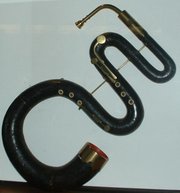
An English serpent 3Often the exact contra instrument to be used was not specified, so the instrument of choice varied in different countries or cities. This suggested the trombone in Paris, or the serpent in London. The contrabassoon was used in Vienna, while Rosetti played the violone at Öttingen Wallerstein. In the 19th century at Sondershausen both the trombone and basshorn were used. The title page of the Vienna edition of Krommer's Harmonien calls for "grosse Fagott" while the French edition asks for "Trombone ou contrebasse". One would presume composers accounted for some flexibility in this matter. Even Mozart, in scoring for contrabass in his B-flat Serenade, despite his clear markings of pizzicato and col arco markings, wrote the doublebass line down to a great C, clearly below its range. Perhaps Mozart was not unwilling to use contrabassoon as a replacement.5
PERFORMANCE VENUES
By the 19th century music concert series would become a pervasive practice. With the exception of opera, though, this was not the norm in the 18th century, so harmonie made its mark instead as popular social entertainment. As Harmonie provided "dinner" and "after dinner" music for the emperor in Vienna, it was also popular among the lower aristocracy and wealthy middle class who clamored to have their own "in house" Harmonie. No better example exists than the scene in the second act of Mozart's opera Don Giovanni where the Don's private Harmonie entertains him with popular melodies during supper. Not to be left out, the working class began hiring Harmonie for special events such as weddings.
Centuries of town musicians, tower musicians, guildmasters, etc., served as a grand precedent for this style of indoor/outdoor entertainment. Harmoniemusik was heard in such diverse conditions as dinner music for the emperor or outdoor entertainment in the Vauxhall Gardens of London, as well as musicians wandering the streets of Vienna or setting the ambiance in the local taverns. Mozart himself was pleasantly surprised to hear his own E-flat Serenade late one night from the street courtyard below his chamber window as he was about to undress, as the quote at the head of the chapter alludes.
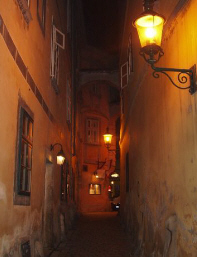
A back street in old Vienna 4A vivid impression of these types of performances is found in a quotation from the Vienna Theatre Almanac for 1794:
During the summer months, if the weather is fine, one can encounter a serenade in the street any day and at any time of day, possibly at one o'clock in the morning or even later. These serenades, however, do not consist merely of a vocalist accompanied by a guitar, mandora or similar instrument, as is the practice in Italy or Spain; here serenades are not performed in order to express one's sighs or declare one's love, for which there are a thousand more comfortable opportunities; these serenades consist rather of quartets, quintets or sextets performed by wind instruments, sometimes by a whole orchestra . . . These performances at night show clearly how widely and intensely music is loved; no matter how late at night it may be, even at an hour at which everyone is hurrying home, people may soon be observed at their windows, and in a few minutes the musicians are surrounded by a crowd of listeners, who applaud, frequently demanding that a piece be repeated, as though they were in the theatre, rarely departing until the serenade is concluded and often accompanying the band in large numbers to another part of the town.6
HARMONIE LITERATURE
Opera Arrangements
In an age before copyright laws opera arrangements posed quite a dilemma for composers intent on reaping all possible financial gain from their compositions. Indeed, on the heels of the success of his opera Die Entführung aus dem Serail, Mozart scurried to beat his rivals to the punch:
Well, I am up to the eyes in work, for by Sunday week I have to arrange my opera for wind-instruments. If I don't, someone will anticipate me and secure the profits.1
On some occasions Harmonie arrangements were written and performed before the opera premiere! 2
Original compositions for Harmonie consisted of multi-movement forms such as partitas, divertimenti, or serenades the style of which was an outgrowth of the Baroque suite. The sonata principle or sonata-allegro form [single movement form in three parts (exposition, development, and recapitulation) which typically involve two major themes featured in contrasting keys in the exposition] stressing the interplay between the tonic and dominant was also common. With the absence of valves, the French horn compensated for the change in tonal centers through the use of various lengths of crooks which changed the length of the horn to compensate for a variety of key relationships. Major composers who wrote original harmoniemusik included Haydn, Mozart, Beethoven, and Schubert, while quality works also came from lesser-known composers such as J. C. Bach, W. F. E. Bach, Hummel, Rosetti, Druschetzky, Krommer, Dittersdorf, and Hoffmeister. In addition to original works, an even greater amount of music was arranged for Harmonie. Operas were the heavy favorite and became quite a sought-after employment. Wind instruments could copy vocal styles in various registers, and having eight players allowed enough voices to provide accompaniment to the melody. The addition of a contrabass provided increased sonority.7
The French preceded the Viennese in adapting opera for Harmonie, but with a decidedly different twist. The Viennese customarily transcribed an opera in sequence, while abbreviating or cutting out certain sections, so that the bulk of the music was chronologically intact. These could contain as many as 24 movements. The French preceded this practice by arranging only the best-loved sequences into a suite. Sometimes a suite would contain movements from several works, not just one. Some suites included movements from a variety of composers, while others compiled selections from just one.8
In Vienna, which rapidly became the center of Harmonie, Johann Wendt was the most famous arranger, having transcribed numerous operas, including works of Salieri and Mozart. Wendt's success no doubt influenced his employer, the emperor, as the court library holds few original compositions from this period, even lacking Mozart's Serenades.9
The common practice during this time was for every noble household to provide its own music. For those financially unable to sustain a full orchestra, one could at least retain a small band of competent wind players. In many cases these musicians were little more than serfs, making them part of the ruler's possessions. Not all fared as well as Haydn, who was eventually granted travel privileges to England. The concept of economic and artistic freedom that pervaded Beethoven's career was still as yet virtually unknown. The following account describes the court musician's situation of servitude as less than amiable:
Stich, known as Punto, was born near Tetschen in Bohemia about 1755. He was a serf of Count Thun, who sent him to Dresden to study the horn with a good fellow named Hampel, and then took him back into his service again in Prague. This service, however, became a double penance to Stich, who was both ambitious and merry: not only did his master adamantly refuse to let him wear a sword, but, whenever the young man let his sense of humour get the better of him he even threatened to make him wear livery. This indignity would have been too much for one of his nature and talents. He therefore seized an opportunity and crossed the Bohemian border into the Holy Roman Empire in the company of four other musicians, the leading horn player, two clarinetists and a bassoonist, hoping to obtain their liberty and perhaps make their fortunes as well. As soon as Count Thun heard of their escape he ordered that they should be pursued and that Stich in particular should be apprehended, and that if he could not be captured outright he should at least have his front teeth knocked in so that he should be unable to play the horn. For that reason Stich translated his name into Italian and from then on called himself Punto.10
Nevertheless, the wind players of Bohemia were renowned for their expertise, and such success would suggest that the experience of Stich was somewhat outside the norm.
Of the numerous ensembles established throughout east central Europe, several deserve special note. These include ensembles formed by the Kaiser, Maximilian Franz, Prince Liechtenstein, Prince Kraft Ernst at Wallerstein, Prince Schwarzenberg, Elector Maximilian Fanz, and Prince Karl Egon von Fürstenberg . Much of their repertoire consisted of opera transcriptions.
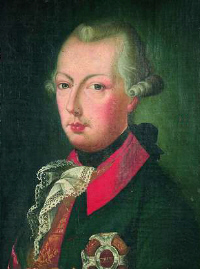
Emperor Joseph II 5On April 1, 1782 Emperor Joseph II formed his own Harmonie, thus ensuring Harmonie a healthy existence, albeit for a relatively short period. The selected musicians were wind players from the Burgtheater opera orchestra. The following description of this ensemble is preserved from Cramer's Magazin der Musik and even lists the performers:
Among all kinds of musical news which has been related to me, one piece that was to me especially remarkable concerned a group of musicians organized by the Kaiser, the sound of whose wind instruments has achieved a new high level of perfection. It is known in Vienna as the kaiserlich-königlich Harmonie. This group consists of eight persons, it performs by itself as a complete and full ensemble. In it they even perform pieces which are in fact intended only for voices, such as choruses, duos, trios and even arias from the best operas; the places of the vocal parts are taken by the oboe and clarinet. One of this Harmonie, the virtuoso and composer Wehend, has arranged them. The names of the musicians were given to me: - Trimsee, ob 1, Wehend;, ob 2, Stadler, cl 1, Stadtler (brother), cl 2, Kautzner, bs 1, Druben, bn 2 (they say he even better than the first), Rupp, hn 1, Eisen, hn 2, (Reputed to be better than Mr. Rupp). C.F.C.11
This quote emphasizes three important facts: first, the players were the best to be found in Vienna at that time, Wendt (Wehend) was chief arranger, and the repertoire emphasizing opera transcriptions appeared to be new. Wendt, who joined the Burgtheater orchestra on January 1, 1777, remained as director of the Harmonie until his death, possibly in 1801. Although Wendt wrote some original works for the Kaiser's Harmonie, it is through his transcriptions that he is best known. These included works of Salieri, as well as Mozart's Le Nozze di Figaro, Cosi fan tutte, and Die Entführung aus dem Serail (apparently he beat out Mozart himself in arranging this opera), all scored for 2222. Salieri's Il Ricco d'un giorno was scored substituting bassett horns for clarinets, no doubt to showcase the Stadtler brothers' acquisition of new instruments.12 As might be expected, the library holdings of the Kaiser were extensive, totaling 169 individual selections, representing many transcriptions of works written well into the 19th century, including Weber, Rossini, Meyerbeer, Bellini, and Donizetti. A number of these later transcriptions were written for 12 players, which fulfilled the increased demands of the later operas. No entries exist after 1837. By then, Kaiser Franz II had been dead for two years, and his successor, Ferdinand I, had little need for what had become an archaic ensemble form.13
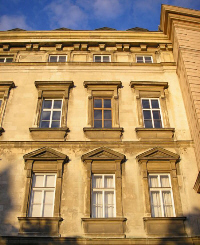
The Liechtenstein palace in Vienna 6One first encounters the efforts of Prince Aloys von Liechtenstein to form a Harmonie through Mozart's desire to secure employment writing for the planned ensemble. Mozart's hopes never came to fruition. For whatever reason, the prince did not hastily form his ensemble. Eventually, some twelve years later, the prince formed what would become a long-standing Harmonie, as is evident by the presence of Joseph Triebensee, a prolific transcriber, composer, and publisher who headed the prince's Harmoniemusik until its demise in 1809. Triebensee was a solo oboist in Vienna, who upon being accepted as the director for the prince's Harmonie proceeded to play an active role as director, first oboe, and transcriber of a vast number of operas and ballets, in addition to composing a number of original works. Indeed, there is circumstantial evidence that he even produced a collection of Harmoniemusik for the Kaiser. Triebensee made a particular effort at selling his work by means of an advertisement in the Allgemeine Muskalische Zeitung for 1804. This was the music journal with perhaps the most widely held circulation. The advertisement listed a collection of the newest and best operas, ballets, as well as original partitas for 2222. Upon release from the prince, Triebensee did a second publication, also in installments, presumably between 1809-1812. It is not known who exactly bought these arrangements, since the Kaiser's Harmoniemusik was rapidly becoming the last surviving Harmonie. Apparently as an art form, Harmonie was still much in demand, perhaps by amateur players or the military.14
Fidelio
eine grosse Oper in 2 Aufzügen
von
Ludwig van Beethoven
für
Neun Stimmige Harmonie
eingerichtet von
Wenzl Sedlak
Kapellmeister bey s. Durchlaucht dem Fürst
Johann von Lichtenstein
Wein bey Artaria und Comp.
(Title page for Beethoven's Fidelio
arranged for Harmonie)
Of special interest were the echo partitas written by Triebensee with the echo part covered by the second instrument of each pair--with an added contrabassoon part for a total of nine players. Other versions of echo partitas included 12, even 16 players.15
Triebensee's successor as Kapellmeister at the court of Prince Liechtenstein was Wenzel Sedlak, a clarinet virtuoso who died in 1851. Little is known about him, but he is noted here because of his transcription of Beethoven's Fidelio for Harmonie. Of all the authorized transcriptions for publishing, the transcription for harmonie was the fourth completed, appearing in the Wiener Zeitung on January 27, 1815. Beethoven supervised the earlier piano arrangements quite thoroughly, so it is possible that Sedlak also had his blessings on the cuts used in the Harmonie transcription, although the cuts do not coincide with those of the earlier arrangements. Notably most cuts occur during the last third of the opera, when the music is most dramatic. This is possibly due to the perceived unsuitability of certain passages for wind instruments. Some transcribers were in the habit of transcribing everything, down to the recitative, which often lent itself to a less-than-musical rendering for Harmonie, where the original dramatic action could never be fully appreciated.16
The largest known Harmonie was maintained by Prince Kraft Ernst at Wallerstein, consisting of 12 players--2(fl)2223, and one violone which was played by Kapellmeister Antonio Rosetti himself. Some scores require a fourth horn. The earliest known reference to Harmonie is from 1764, recalling a performance requested by the Prince, then known as Philipp Carl, for Emperor Franz I. The selections were played by clarinets and horns. Flutes were added in 1783, bringing the ensemble to full strength. Also worthy of note is the almost complete absence of transcriptions in the Wallerstein library--six in all. Contained in the library at Schloss Marburg, the Ottingen Wallerstein library includes, in addition to efforts of less known composers, works spanning a period from as early as Hoffmeister and Mozart to Rossini's L'Italiana in Algeri and Tancredi, both dated 1813.17
Prince Schwarzenberg's Harmonie used English horns instead of clarinets--an unusual practice in Vienna. This was due to the presence of the brothers Teimer--Johann, Franz, and Phillip--who were all virtuosi on the oboe and English horn. In fact a considerable part of the repertoire used by the Schwarzenberg Harmonie was written with these players in mind, including no fewer than fourteen trios for two oboes and English horn.
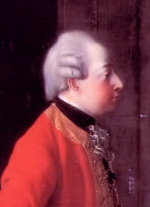
Elector Maximilian Franz 7German Harmonie was not as well established as that of the Viennese, with the exception of that of Maximilian Franz who went to Bonn as Elector of Cologne in 1784 (the last to hold the office because of the Napoleonic wars in 1794). This Harmonie was somewhat an exception because it originated in Vienna, prior to Maximilian Franz's appointment, and played opera transcriptions--a practice not as prevalent in Bonn as in Vienna.18
The other German court most closely allied with the Viennese tradition was that of Prince Karl Egon von Fürstenberg at Donaueschingen. Here lies the largest existing library outside Eastern Europe and Vienna, containing both original works and transcriptions. The prince frequently spent the season in Vienna, so there was most likely a strong connection to the Harmonie tradition there. Evidence from the library implies this was a long and healthy Harmonie, perhaps predating the octet format of the Viennese ensembles. It contains manuscripts of three octets by Myslivecek, who died in 1781, one year before the beginning of full Harmonie in Vienna. This is suggested, despite any definite records that Myslivecek was residing at Donaueschingen at the time. Also, the instrumentation was varied, sometimes substituting English horn, and even using flute on a limited basis.19
Much of Franz Josef Haydn's work in this medium was not known to exist until the late 1950s when archives of Moravia and Bohemia were opened. One can only speculate how much more literature is lost forever, since a considerable amount of this music was never published during Haydn's lifetime.
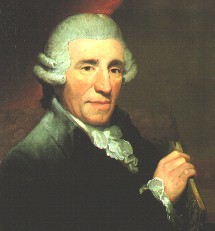
Franz Josef Haydn 8The year 1759 was a turning point in Haydn's career due to his appointment he received as Kapellmeister to Count Maximilian von Morzin of Bohemia. This appointment not only rescued Haydn from eking out an existence as a music teacher--an existence which assuredly left little time for composition--but the very requirements of the appointment provided time and encouragement to write. Bohemia was known for its excellent wind players, so it was not only a natural outcome but also probably a requirement from the prince that Haydn should write in this medium. The court spent winters in Vienna and summers at the Count's castle at Lukavec near Pilsen. The count's band consisted of fifteen members, occasionally augmented by members of the household. With this group, Haydn performed music at mealtime, as well as serenades after supper in the evening. This was the first opportunity for Haydn to include clarinets in his scoring. Accurate dating is hard for this literature, as some is dated as late as 1761 when Haydn had moved to Esterházy. It is unclear as to whether Haydn simply brought music from his previous employment, or actually composed new works for this venture. Adding to the confusion is the inclusion of clarinets in this music. H. C. Robbins Landon suggests that clarinets were normally not available at this early date at the Esterházy court. So possibly works such as the Divertimento in C major for two clarinets and two horns were written for the visit of the dilettante player, Count Nichael Casimir Oginski, who was a guest of the Esterházy palace in Vienna in 1761.20 Dieter Klöcker claims that internal and external evidence also suggests the possibility that octet writing may have occurred much later than 1761, since Haydn had at his disposal the complete wind section of the band of the Prince of Wales during his visits to England.21
So, a fair amount of Haydn's literature in this genre has slowly come to us in the form of Partitas and Divertimenti scored for pairs of oboes, horns, and bassoons, or clarinets, horns, and bassoons, or clarinets, oboes, horns, and bassoons--all reinforced by the contrabassoon, ad libitum. Light in style as most music of this genre tends to be, they also represent the early Classical style in its quintessential form. For example, compare the Divertimento in F major with the Divertimento in E-flat Major. The former contains little development, has thematic material fitting into predictable yet lyrical four-measure phrases, and lacks an introduction, while the latter contains melodies more highly developed in movements which are more weighty in length. All selections nevertheless call for a higher level of musicianship and technique than was sometimes required in other forms of music, especially the developing symphonic form in which the strings carried precedence over the winds. Haydn's contributions to this genre were, like his quartets and symphonies, early examples for later composers to emulate.
The "flagship" of Harmoniemusik is the three serenades of W. A. Mozart. These were written during the years from 1781-1782 when he was emerging as a mature composer, and eager to establish himself in Vienna. Indeed, these works seem to have been written to foster recognition among aristocratic circles so as to gain employment.

Wolfgang Amadeus Mozart 9The earliest example, the Serenade in E-flat (referred to above) was written in 1781 originally as a sextet (2 cl, 2 hn, 2 bsn). Mozart composed this music for Therese von Hickl whose brother was court painter to the emperor. Mozart also knew that Johann Kilian Strack, the emperor's valet-de-chambre, frequented the lady's house, thus allowing his music direct exposure to personages of the emperor's court. After the emperor formed his octet in April of 1782, Mozart rearranged the serenade to include a pair of oboes, no doubt to enhance the opportunity for a hearing with the court ensemble. All five movements of the serenade are in E-flat, possibly to facilitate the use of valve-less horns. The two outer allegro movements contrast the minuets and adagio of the second, third, and fourth movements.
The pathos found in the opening strains of the C minor Serenade, K.388, is in blunt contrast to its cheerful predecessor. Written in July of 1782, one can only speculate as to the motivation for this work. The four movements with their more serious ambience suggest a work of symphonic intent as opposed to that of a serenade. One suggestion is that it was written for Prince Alois Liechtenstein, whom he hoped to serve as court composer. In fact, Mozart, in a letter to his father dated January 23, 1782, alluded to his hope for steady income from the prince:
Well, I want to give you my opinion as to my prospects of a small permanent income. I have my eye here on three sources.... The first is young Prince Liechtenstein, who would like to collect a wind-instrument band (although he does not yet want it to be known), for which I should write the music. This would not bring in very much, it is true, but it would be a least something certain, and I should not sign the contract unless it were to be for life.22
Mozart was passed over for the appointment.
The Serenade in B-flat, K.361 subtitled "Gran Partita" is certainly grand--not only in quality but also in length and scope. This seven-movement work requires thirteen players, with six pairs of winds: oboes, clarinets, and basset horns for melody and upper harmony, bassoons, and French horns in F and in B-flat, plus the addition of one string bass. The depth of harmonic and timbre possibilities make for a stupendous work--two sets of horns make key changes more accessible, and the contrabass provides additional sonority to the bass line. This frees the 1st bassoon to engage in the tenor line, or to complement the 2nd bassoon in octaves, thirds, or unison. There is an expansive feel to this work--an introduction to the opening allegro, two minuets with second trios, plus two extra movements sandwiched between the second minuet and the finale.
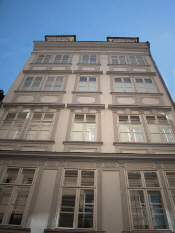
Mozart's apartment house
in Vienna 10The Serenade in B-flat is often referred to as the "Gran Partita" from words written on the first page of the autograph (actually penned 'Gran Partitta'). However the handwriting is not Mozart's, and the text's red color matches nothing else in the manuscript, so the subtitle appears to have been added at a later time by someone else.
Early opinions erroneously suggest that the B-flat Serenade was begun in Munich, but watermarks on the paper suggest it was written in the early Viennese period, c.1782. Roger Hellyer, a scholar of Mozart and Harmonie, suggests that possibly the B-flat Serenade was a wedding present for Constanze in 1782.
Evidence of the first known performance of this work points to the spring of 1784, with four of the seven movements performed. It is not clear as to whether the other three movements existed at that time or were written later. Anton Stadtler, who was one of two clarinetists with the emperor's Harmonie, included this work on a concert during the Lenten season. This was the time of year that musicians of the nobility were given vacation, so Stadler had the pick of the best musicians for his efforts. In the Wienerblättchen advertisement Stadler suggests that he commissioned Mozart to write a "great wind piece of a very special kind." One can speculate whether indeed Mozart wrote a new piece or instead dusted off an earlier manuscript that had not previously been performed in public or otherwise. The performance at the Burgtheater on March 23, 1784 received the following response from one critic, one J. F. Schink:
A master sat at every instrument-and oh, what an effect!-magnificent and grand...Mozart. There's life here, like the land of the blessed, the land of music...
At some point in time the autograph score was returned to Mozart, because upon his death it became the property of Constanze, who disposed of it in 1799 as part of a sale of all remaining autograph materials. It passed through numerous hands over a period of 140 years, before being sold to the Library of Congress in Washington, D.C. in 1941, where it now resides.
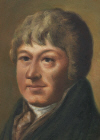
Franz Krommer 11A prolific and successful composer of Harmonie, Franz Krommer's works are found in libraries in England, America, and across the European continent. Thirteen of his works were published in two separate editions, first in Vienna at the turn of the century, then in Paris in the 1820's. Twelve of these were in the Kaiser's library. The only library now known to have a full set is the Royal College of Music in London. His works were written for 2222 plus a contrabassoon in the printed works, with an occasional trumpet included. He stood with Mozart as a complete master of the octet writing for Harmonie. Hellyer maintains that Krommer's music was so indigenous to the form that it might very well sound nonsensical if transcribed into another medium.23

Ludwig van Beethoven 12Ludwig van Beethoven wrote a number of wind pieces early in his career. Two of them, the Octet, Op. 103, and Rondino, WoO 25, date from the same period, c.1792, and require the same instrumentation, 2222. The octet was written for the forces in the employment of Elector Maximilian Franz in Bonn shortly before Beethoven's departure to Vienna. Upon arrival in Vienna, it was Beethoven's goal to study with Haydn, and rather than write new pieces to submit to the master, he decided to revise some earlier works. One such work was the Octet. He wrote the Rondino as a finale to the Octet before quickly changing his mind and submitting the present final movement, which may have been the original finale. The Rondino was originally titled Rondo, the name being changed in 1830 when the work was finally published. This brief work should stand out if only because of its frequent use of the French horn as a melodic instrument. The Sextet in E-flat, Op. 71 was first performed in April, 1805, though possibly written earlier. Beethoven waited until 1809 to submit it to Breitkopf and Hartel (who published it a year later) with the following note:
The sextet is one of my earlier things and, moreover, was written in a single night - nothing can really be said of it beyond that it was written by an author who at least has produced a few better works; yet for many people such works are the best.24
Whether written as an apology for an ensemble medium he now felt beneath his efforts, or simply false modesty, Beethoven surely did not compose such a work in the rapid manner suggested, since fairly extensive sketches of the third and fourth movements have come to light. The work's premiere was given a glowing report from the often critical Allgemeine Musikalische Zeitung. It said that of all the works performed at the concert "the most especially pleasing was the beautiful Sextet in E-flat of Beethoven, a composition distinguished by fine melodies, a natural harmonic flow and a wealth of new and surprising ideas." Whether or not they reach the level of Mozart's efforts, these wind pieces are still worthy ventures and very listenable, much in the classical Harmonie style, punctuated with beautiful lyricism, yet contrasting gaiety and contemplative moments. Yet one hears a foreshadowing of things to come, for instance, in the tempo of the minuet in the Octet, which is more like the scherzo tempo he would later come to prefer. They also stand as early examples of his scoring for winds--efforts that directly influenced his nine symphonies. In fact one reviewer of the premier of his First Symphony complained that "the wind instruments were employed excessively, so that it was more military band than orchestral music."25
Brief mention must be made of the two surviving works of Franz Schubert. They consist of an octet written in 1813, of which only the Minuet, Finale, and a fragment of the first movement are survive, and the very short Eine Kleine Trauermusik scored for 2cl, 2bsn, Cbsn, 2hn, 2tbn.
As a religious body, the Moravians have roots that date back to the protestant leader John Huss whose protest against the Catholic Church preceded that of Martin Luther. Long known for a rich heritage of sacred music, the Moravians continued that tradition upon arrival in America. Their anthems, consisting of chorus with instrumental accompaniment, were written in a style similar to J. S. Bach or G. F. Handel. While their music had little impact on mainstream musical practices in the American colonies, its admirers included George Washington, Benjamin Franklin, and John Adams.26 In time their interest turned increasingly to secular instrumental music as a vital art form. At the beginning of the 19th century, as Harmonie was entering the twilight years of its popularity in Europe, it took on new life in the Moravian colonies of the then young United States. The steady arrival of music, instruments, and personnel allowed for an ever-increasing focus on woodwind chamber music. Evidence that this Harmoniemusik took on an increasing role in the activities of the Brethren's Collegia musica is noted in the Moravian archives located in their colonies at Bethlehem, Pennsylvania and Winston-Salem, North Carolina. Some of the better-known composers whose works found a place in these libraries were Hoffmeister, Rosetti, and Pleyel. Their most popular instrumentation was an ensemble of clarinets, horns, and bassoons.27
Included in the Collegia musica libraries are works of special interest written by the Moravian David Moritz Michael (1751-1827). Michael, who was born and educated in Germany, was a musician of exceptional ability. While at Bethlehem, Pennsylvania he reorganized the Collegia musica and in 1811 directed the Collegium musicum in the first American performance of Haydn's Creation. During this stay at Bethlehem, he wrote what is considered to be the earliest woodwind music (Harmonie) composed in this country. He came by this interest naturally, having been an oboist and French horn player in German pit orchestras and military bands prior to his arrival in America. Among his various choral and instrumental works written while in America are some fourteen partitas and two well-publicized "water music" suites. A number of these popular "Pennsylvania" works found their way south into the library of the Collegium musicum in Salem, North Carolina about 1810.28
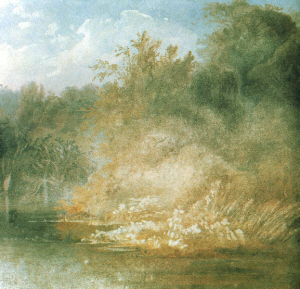
Forest Scene on the Lehigh, Karl Bodmer, 1832 13While this Harmoniemusik probably began as indoor concert music, in time this delightful, gay offering soon found its way to the outdoors. Bethlehem's residents gathered for concerts in the evening outside the Single Brethren's House while in nearby Nazareth the Black Rock Spring, a favorite picnic area, provided the logical setting. One of the more auspicious occasions centered on the annual observance of Whitmonday in Bethlehem. A festive mood prevailed as the townsfolk gathered for strolls along the banks of the Lehigh River. In 1808, to add to the occasion, a barge floated down the river with an ensemble of clarinets, horns, and bassoons assembled on the barge to play a variety of marches, minuets, and similar selections appropriate for the occasion. David Moritz, in addition to performing with the group, also supplied most of the music for this event. Of special interest were his "water music" suites: Bey einer Quelle zu Blasen ("To be played by a spring", 1808) and Bestimmt zu einer Wasserfahrt auf der Lecha ("Intended for a boat excursion on the Lehigh", 1809). The first of these is essentially a "suite of suites" containing three short four-movement suites, while the second is a work of fifteen movements. Moritz's work straddles the Classical and Romantic periods, so in addition to graceful melodies, these works also contain moments of programmatic impressions, as might be expected on an excursion down a picturesque river.29
This early wind music extended the life of the dying art of harmoniemusik of Europe. At the same time, this form, coupled with the use of the trombone choir in Moravian sacred music, provided the foundation for a great band tradition to come in the middle 19th century, such as the popular brass bands located at the colony of Salem, North Carolina. This was a vital link in the growth and heritage of the band movement in the United States.
While Harmoniemusik was developing in Western Europe, in Russia a unique and bizarre custom of wind playing developed. Sometimes truth is stranger than fiction, and this would certainly seem to be so in this case. Prince Kirilovich Narishkin, the Master of the Hunt to the Empress Elizabeth, had become frustrated with the sound coming from the horns used to signal the progress of the hunt. The coppersmith on Narishkin's estate made the horns in question, and apparently no attempt towards consistency of pitch had been made. So in 1751 the prince had sixteen new instruments made which were tuned to play a D major chord. The technique of overblowing was not taught on these simple instruments, so standard practice called for a single note to be played on each horn.
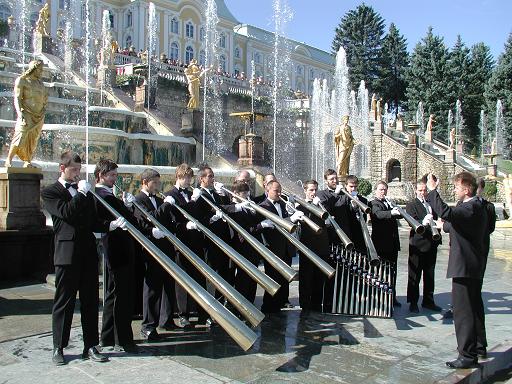
The Russian Horn Capella in front of the Peterhof Fountains, St. Petersburg 14The result was so pleasing and consonant that Narishkin asked a chamber musician, J. A. Maresch, to combine these horns with more refined brass in order to provide a concert performance. Maresch was a Bohemian who had to come to Russia to seek his fortune, and in time came to the court of Elizabeth as a French horn player. The events that unfolded would make him famous throughout Europe--at least for a time. Maresch had to train the serfs who played the hunting horns to count the beats of a measure and to read a rudimentary form of rhythmic notation which he designed for the occasion. The music selection performed is not known, but the instrumentation was twelve French horns, two trumpets, and two posthorns, supported by the hunting horns. Using six French horns in D, two in A, two in G, one in C-sharp and one in E, a complete scale in D was available combined with the D chord played by the hunting horns. Obviously the hunting horns were limited to little more than fanfare-type passages.30
Narishkin was pleased with the performance, so he directed Maresch to continue the practice, with one alteration. Narishkin was frustrated that Maresch had to employ French horn players from surrounding estates, so he directed the musician to teach twelve serfs to play French horn and gave him only one year's time to accomplish the feat. Maresch realized that the directive was impossible to carry out, so he devised a plan of his own. In secret he taught the serfs some simple three-voiced compositions on the single-toned instruments, each serf responsible for only one note. The rehearsed ensemble was presented in concert in sufficient time and met with the approval of the Prince. As a result, Narishkin suggested that they forgo the use of French horns altogether, so it became necessary to build additional horns of various sizes to produce the pitches required by more advanced selections of music. Since each player played only one note, the size of the ensemble was determined by the total number of pitches required in each piece. Maresch's band had enough players for three complete octaves, assembled in four rows somewhat like the rows of a pipe organ. Indeed, a pipe organ seemed to become the sound that many alluded to when describing the sound of this type of ensemble.31
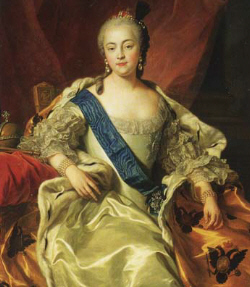
Empress Elizabeth of Russia 15A concert in 1757 for the Empress Elizabeth was the catalyst that encouraged the duplication of this type of ensemble across Russia. While many qualities were pervasive to all ensembles, some bands developed stylistic traits more suitable to their tastes. Some bands, for instance, allowed the horns to overblow so as to play higher overtones, thus increasing the range upward. Other bands used an additional key so as to allow each instrument to play a half step higher when needed, while still others expected some players to be responsible for playing more than one horn.32
Despite the obvious technical limitations, in time the Horn Band played with a considerable amount of proficiency. Upon hearing the Russian Imperial Horn Band in 1803, Louis Spohr commented:
The hornists executed an overture by Gluck with a rapidity and exactness which would have been difficult for stringed instruments; how much the more so, then, for hornists, each of whom blew only one tone! It is hardly to be believed that they performed the most rapid passages with the greatest precision, and I could not have conceived it possible had I not heard it with my own ears.33
Joseph II and the Horn Band
Perhaps the most telling response to the adaptability of the horn band was attributed to Austrian Emperor Joseph II who visited the Tsar's residence, Peterhof, near St. Petersburg. He was fascinated upon hearing the Russian horns for the first time and requested an audience with Maresch. After hearing an explanation of the mechanism of the music he commented:
Bravo! that's fine! Only you require forty men of this work which I can accomplish with one man, playing the organ. But then you have here numbers of men, enough to form easily a couple of companies!3
Not all reviews were so flattering. It appears that there was no general consensus as to what to think of these ensembles. A review in the Harmonicon of a London concert in December 1831 suggested that the audience heard a first-rate band of Russian horns, but a second-rate band of wind instruments, citing a lack of expression and a shrill and out of tune upper register.34 The volume of this type of ensemble must have been immense. J. C. Hinrichs, upon describing the Horn Band in 1796, said that on a quiet night a horn band could be heard up to a "German mile", which was the equivalent of five English miles. As a result several methods were employed in an effort to provide more dynamic contrast. One was to build leather-covered wooden horns. Maresch's effort entailed having the players stand in a circle around a hollow box. To play more softly, the horn was inserted through a hole in the side of the box so as to muffle the sound.35
Ironically, in the end it was not musical limitations but social changes that eventually caused the demise of the Horn Band. First, the number of bands declined rapidly in the early 19th century during the Napoleonic wars, when the serf musicians were drafted into battle. Also, in time, the performers who were bought and sold with the instruments they played were given their freedom.36 In a time of heightened social awareness even the very idea of the Russian Horn Band drew criticism for the exploitation many people perceived it to foster. Referring back to the account of the London concert of 1831, the Harmonicon wrote:
Of all the ingenious devices for reducing man to the level of a machine,...this is, perhaps, the most curious; a number of persons are trained to hit with unerring precision, to the infinitesimal part of a second, the very instant when each is to produce a sound from a tune, the sounding of which, in exact time, is the whole business of his musical existence. The bare idea of devoting so many fellow-creatures to the drilling necessary to the acquirement of this clockwork regularity could have been conceived only by one who had but to will and be obeyed; and the dis-heartening drudgery of learning the art would have been submitted to only by those who were habituated to consider the commands of their superiors the sole law of their actions. Accordingly, it is in Russia that we find this instrument invented, and that at a period when the ancient hereditary tyranny of its princes and nobles was as yet unsoftened...37
No doubt the use of serfs who were tied monetarily to the whims of their master was as much an impetus for this harsh criticism as the perceived monotony which the Horn Band activity engendered. However, one has to wonder if life in the horn band was any worse than any other task that a serf might have been required to undertake. One only has to be reminded of the large numbers of volunteers that gladly participate today in hand bell choirs in innumerable churches and schools to acknowledge that there must have been some artistic enjoyment gained by the ensemble members.
CONCLUSION
Harmoniemusick continued into the early 19th century, but would soon die out as the radical political reforms in France transformed the wind band into an entity that would become the prototype of the contemporary concert band.
ENDNOTES
1Emily Anderson, ed., The Letters of Mozart and His Family, Vol. II (New York: MacMillan, 1966) p. 776.
2Throughout this discussion the numerical reference will allude to the use of instruments in the following order: 2222 represents 2 oboes, 2 clarinets, 2 horns, 2 bassoons. Exceptions will be noted thus 2222(1) would suggest the same instrumentation with the addition of contrabassoon, or 22(2bhn)22(Db) would suggest the octet with the addition of two bassett horns and one Doublebass.
3Roger Hellyer, Harmoniemusik: music for small wind band in the late eighteenth and early nineteenth centuries (Thesis: University of Oxford, 1973), p.47-48.
4Ibid., p. 265-266.
5Ibid., p.181-183.
6Dieter Klöcher, Program Notes for the album Divertimenti für Bläser Vol. I (Hamburg: Teldec "Telefunken-Decca", No. 6.35473, 1980), p. 10.
7Hellyer, p.26.
8Ibid.,p.91-92.
9Ibid., 122-125.
10Klöcker, 10.
11Hellyer, p.121 Footnote to an article on the horn-playing brothers Bock in Cramer's Magazin der Musik on December 21, 1783.
12Ibid., p. 124-125.
13Ibid., p. 130-143.
14Ibid., p. 146-161.
15Ibid., p. 161-163.
16Ibid., p. 168-172.
17Ibid., p. 215-222.
18Ibid., p. 193-196.
19Ibid., p. 202-214.
20H. C. Robbins Landon and David Wyn Jones, Haydn - His Life and Music (Bloomington: Indiana University Press, 1988), 76.
21Klöcher, p. 9.
22Ibid., p. 794.
23Hellyer, p. 277-284.
24Letter 224.
25Joseph Schmidt-Görg, "The Symphonies," Ludwig van Beethoven, edited by Joseph Schmidt-Görg and Hans Schmidt (New York: Praeger Publishers, 1969), p. 25.
26Michael Leavitt, Program notes for America Sings Vol. 1 The Founding Years (1620-1800) The Gregg Smith Singers. Recording on Vox Label.
27Harry Hobart Hall, The Moravian Wind Ensemble: Distinctive Chapter in America's Music (Ph.D. diss., George Peabody College for Teachers, 1967) p. 183-185.
28Ibid., 187-188.
29Ibid., 201-203.
30Robert Ricks, "Russian Horn Bands", The Musical Quarterly vol. LV, No. 3 (July, 1969) p.364-365.
31Ibid., 365-366.
32Ibid., 367.
33Louis Spohr, Autobiography, trans. anon. (London, 1878), I, 46.
34Ricks, 367-368.
35Ibid., 369.
36Loc. cit.
37"Russian Horn Music", The Harmonicon (December, 1831), 12, as cited in The Musical Quarterly, Vol. LV, No. 3, (July, 1969), 370.
SIDEBAR NOTES
1Letter to his father, July 20, 1782. Anderson, Emily. Vol. II, p. 808.
2Hellyer, p. 26.
3Jaroslow De Zielinski, "Russian Hunting Music," The Musical Quarterly Vol. III, 1917, p. 5.
PICTURE CREDITS
1Detail from engraving showing the 1st Foot Guards band, unknown artist and source, 1753. From the web site www.waits.org.uk/. Used by permission.
Source: http://www.waits.org.uk/pictures/footguards.jpg.
3Photograph of an English serpent, taken by Gaius Cornelius, 2006. Released into public domain by photographer.
Source: http://commons.wikimedia.org/wiki/Image:Serpent_%28musical_instrument%29.JPG.
4Photograph of a street in old Vienna, taken by Peter Stadler, 2005. Used by permission.
http://commons.wikimedia.org/wiki/Image:Gasse_Wien_001.jpg.
5Portrait on wood of Emperor Joseph II by H. Tröndle, 1783. Public domain.
Source: http://commons.wikimedia.org/wiki/Image:Joseph_II_by_Tr%C3%B6ndle.jpg.
6Photograph of the Liechtenstein palace on Bankgasse in Vienna, taken by Gryffindor, 2006. Used by permission.
Source: http://commons.wikimedia.org/wiki/Image:Stadtpalais_Liechtenstein_Vienna_Sept_2006_002.jpg.
7Excerpt from portrait of Maximilian Franz visiting his sister Marie Antoinette and Louis XVI, by Joseph Hauzinger, 1775-1777. Public domain.
Source: http://commons.wikimedia.org/wiki/Image:Marie_Antoinette_Adult7.jpg.
8Portrait of Franz Joseph Haydn by Thomas Hardy, 1792. Public domain.
Source: http://commons.wikimedia.org/wiki/Image:Haydn_portrait_by_Thomas_Hardy_%28small%29.jpg.
9Portrait of Wolfgang Amadeus Mozart by Barbara Kraft, 1819. Public domain.
Source: http://commons.wikimedia.org/wiki/Image:Wolfgang-amadeus-mozart_1.jpg.
10Photograph of Mozart's apartment in Vienna, taken by Georges Sansoone, 2006. Used by permission.
Source: http://commons.wikimedia.org/wiki/Image:Wien.Mozarthouse02.jpg.
11Portrait of Franz Krommer, artist unknown. Used by permission.
Source: http://www.naxos.com/images/paintings/Krommer_Franz/Krommer_Franz.jpg.
12Portrait of Ludwig van Beethoven by Ferdinand Waldmuller, 1823. Public domain.
Source: http://commons.wikimedia.org/wiki/Image:Beethoven_Waldmuller_1823.jpg.
13Forest Scene on the Lehigh by Karl Bodmer, 1832. Public domain.
Source: http://commons.wikimedia.org/wiki/Image:Forest_Scene_on_the_Lehigh_by_Karl_Bodmer_1832.jpg.
14Photograph of The Russian Horn Capella, photographer unknown. From the website www.horncappella.com, copyright 2005 The Russian Horn Cappella. Used by permission.
Source: http://www.horncapella.com/media/h2.jpg.
15Portrait of Empress Elizabeth of Russia by Charles Van Loo. Public domain.
Source: http://commons.wikimedia.org/wiki/Image:Elizabeth_empress.jpg.
|
|
